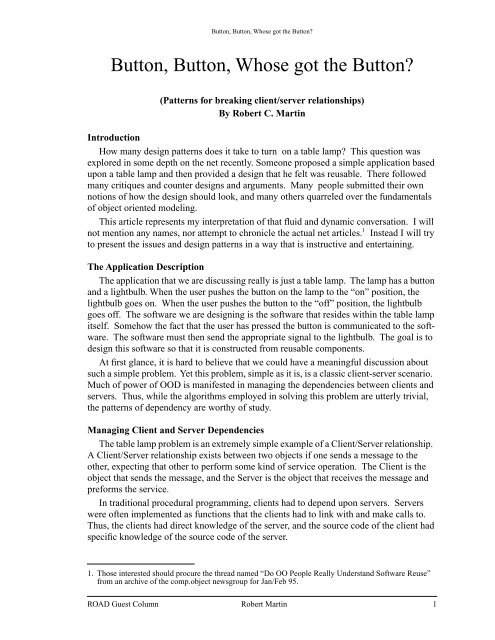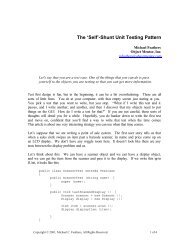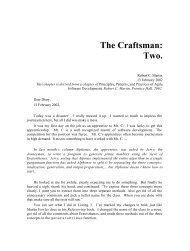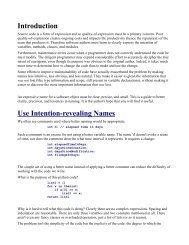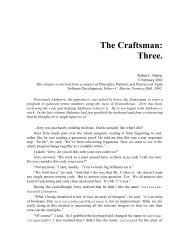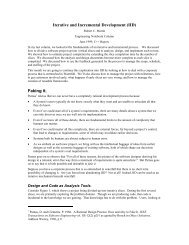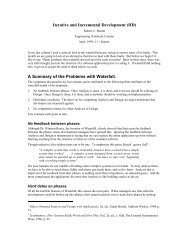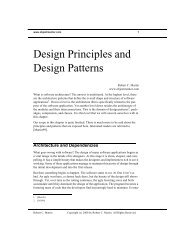Button, Button, Whose got the Button? - Object Mentor
Button, Button, Whose got the Button? - Object Mentor
Button, Button, Whose got the Button? - Object Mentor
You also want an ePaper? Increase the reach of your titles
YUMPU automatically turns print PDFs into web optimized ePapers that Google loves.
<strong>Button</strong>, <strong>Button</strong>, <strong>Whose</strong> <strong>got</strong> <strong>the</strong> <strong>Button</strong>?<strong>Button</strong>, <strong>Button</strong>, <strong>Whose</strong> <strong>got</strong> <strong>the</strong> <strong>Button</strong>?(Patterns for breaking client/server relationships)By Robert C. MartinIntroductionHow many design patterns does it take to turn on a table lamp? This question wasexplored in some depth on <strong>the</strong> net recently. Someone proposed a simple application basedupon a table lamp and <strong>the</strong>n provided a design that he felt was reusable. There followedmany critiques and counter designs and arguments. Many people submitted <strong>the</strong>ir ownnotions of how <strong>the</strong> design should look, and many o<strong>the</strong>rs quarreled over <strong>the</strong> fundamentalsof object oriented modeling.This article represents my interpretation of that fluid and dynamic conversation. I willnot mention any names, nor attempt to chronicle <strong>the</strong> actual net articles. 1 Instead I will tryto present <strong>the</strong> issues and design patterns in a way that is instructive and entertaining.The Application DescriptionThe application that we are discussing really is just a table lamp. The lamp has a buttonand a lightbulb. When <strong>the</strong> user pushes <strong>the</strong> button on <strong>the</strong> lamp to <strong>the</strong> “on” position, <strong>the</strong>lightbulb goes on. When <strong>the</strong> user pushes <strong>the</strong> button to <strong>the</strong> “off” position, <strong>the</strong> lightbulbgoes off. The software we are designing is <strong>the</strong> software that resides within <strong>the</strong> table lampitself. Somehow <strong>the</strong> fact that <strong>the</strong> user has pressed <strong>the</strong> button is communicated to <strong>the</strong> software.The software must <strong>the</strong>n send <strong>the</strong> appropriate signal to <strong>the</strong> lightbulb. The goal is todesign this software so that it is constructed from reusable components.At first glance, it is hard to believe that we could have a meaningful discussion aboutsuch a simple problem. Yet this problem, simple as it is, is a classic client-server scenario.Much of power of OOD is manifested in managing <strong>the</strong> dependencies between clients andservers. Thus, while <strong>the</strong> algorithms employed in solving this problem are utterly trivial,<strong>the</strong> patterns of dependency are worthy of study.Managing Client and Server DependenciesThe table lamp problem is an extremely simple example of a Client/Server relationship.A Client/Server relationship exists between two objects if one sends a message to <strong>the</strong>o<strong>the</strong>r, expecting that o<strong>the</strong>r to perform some kind of service operation. The Client is <strong>the</strong>object that sends <strong>the</strong> message, and <strong>the</strong> Server is <strong>the</strong> object that receives <strong>the</strong> message andpreforms <strong>the</strong> service.In traditional procedural programming, clients had to depend upon servers. Serverswere often implemented as functions that <strong>the</strong> clients had to link with and make calls to.Thus, <strong>the</strong> clients had direct knowledge of <strong>the</strong> server, and <strong>the</strong> source code of <strong>the</strong> client hadspecific knowledge of <strong>the</strong> source code of <strong>the</strong> server.1. Those interested should procure <strong>the</strong> thread named “Do OO People Really Understand Software Reuse”from an archive of <strong>the</strong> comp.object newsgroup for Jan/Feb 95.ROAD Guest Column Robert Martin 1
<strong>Button</strong>, <strong>Button</strong>, <strong>Whose</strong> <strong>got</strong> <strong>the</strong> <strong>Button</strong>?In OOD we often find it desirable to break <strong>the</strong> dependency of <strong>the</strong> client upon <strong>the</strong> server.This allows <strong>the</strong> client to be used with many different servers, so long as <strong>the</strong>y all conformto <strong>the</strong> same interface. It also isolates <strong>the</strong> client from <strong>the</strong> server such that if <strong>the</strong> source codeof <strong>the</strong> server is changed, <strong>the</strong> client does not need to be changed or recompiled in turn.This prevents changes from propagating up to clients from servers.Solving <strong>the</strong> ProblemWe can begin to solve <strong>the</strong> table lamp problem by examining <strong>the</strong> two use cases.• When <strong>the</strong> user pushes <strong>the</strong> button to <strong>the</strong> “on” position, <strong>the</strong> system turns <strong>the</strong> lightbulbon.• When <strong>the</strong> user pushes <strong>the</strong> button to <strong>the</strong> “off” position, <strong>the</strong> system turns <strong>the</strong> lightbulboff.These use cases translate nicely into <strong>the</strong> simple object diagrams in Figure 1 andFigure 2. In each case, <strong>the</strong> <strong>Button</strong> object receives some stimulus from <strong>the</strong> outside world<strong>Button</strong>1:TurnOnLightbulbUser pushes"On"FIGURE 1.User pushes button “on”<strong>Button</strong>1:TurnOffLightbulbUser pushes"Off"FIGURE 2.User Pushes <strong>Button</strong> “Off”and <strong>the</strong>n sends <strong>the</strong> appropriate message to <strong>the</strong> Lightbulb object.These two objects were chosen in order to separate <strong>the</strong> software that detects <strong>the</strong> state of<strong>the</strong> button, from <strong>the</strong> software that controls <strong>the</strong> state of <strong>the</strong> lightbulb. I felt that this separationwas important because <strong>the</strong>se two concepts could be reused in very different contexts.That is, buttons could be used to control devices o<strong>the</strong>r than lightbulbs, and lightbulbscould be controlled by objects o<strong>the</strong>r than buttons.ROAD Guest Column Robert Martin 2
<strong>Button</strong>, <strong>Button</strong>, <strong>Whose</strong> <strong>got</strong> <strong>the</strong> <strong>Button</strong>?This ra<strong>the</strong>r simple dynamic model is supported by <strong>the</strong> static model that is shown inFigure 3. The class <strong>Button</strong> contains <strong>the</strong> class Lightbulb This “contains” relationshipresults from <strong>the</strong> fact that instances of <strong>Button</strong> must know what object to send <strong>the</strong> TurnOnand TurnOff messages to. The most common mechanism for satisfying this need is for<strong>Button</strong> to contain Lightbulb in an instance variable.<strong>Button</strong>LightbulbFIGURE 3.<strong>Button</strong> contains LightbulbThe use of <strong>the</strong> “Contains” relationship as shown in Figure 3 spawned a lot of controversy.Several people felt that <strong>the</strong> object model should reflect <strong>the</strong> real world relationshipsbetween a button and a lightbulb. Since, in <strong>the</strong> real world, a button does not contain alightbulb, <strong>the</strong>se people felt that <strong>the</strong> relationship was somehow incorrect.However, containment in OOD is not <strong>the</strong> same as physical containment in <strong>the</strong> realworld. Aggregation of objects may represent real world physical containment; but moreoften it represents some o<strong>the</strong>r kind of physical connection. As Booch says: “...aggregationneed not require physical containment...” 1In Figure 3 I am using aggregation to represent <strong>the</strong> fact that <strong>the</strong>re is a permanent cause/effect relationship between a particular button and a particular lightbulb. If one insistsupon a real-world counterpart for this relationship, <strong>the</strong>n I suppose <strong>the</strong> wire that connects aphysical button to a physical lightbulb can serve. However, in my opinion, far too mucheffort is expended in trying to find real-world justifications for classes and relationships.As Jacobson says: “We do not believe that <strong>the</strong> best (most stable) systems are built by onlyusing objects that correspond to real-life entities...” 2Making <strong>the</strong> <strong>Button</strong> ReusableThe disadvantage of <strong>the</strong> solution in Figure 3 should be clear. While <strong>the</strong> Lightbulbclass is nicely reusable, <strong>the</strong> <strong>Button</strong> class is not. Were this design to be implemented, <strong>the</strong>n<strong>the</strong> source code of <strong>Button</strong> would depend upon <strong>the</strong> source code of Lightbulb, and so <strong>Button</strong>could not be reused without dragging Lightbulb along.This dependence of <strong>the</strong> client (<strong>Button</strong>) upon <strong>the</strong> server (Lightbulb) is <strong>the</strong> hallmark ofprocedural design, ra<strong>the</strong>r than object-oriented design. In procedural design, clientsdepend upon <strong>the</strong>ir servers, and <strong>the</strong> servers are independent. In object-oriented design,abstract polymorphic interfaces are used to break <strong>the</strong> dependence of <strong>the</strong> server upon <strong>the</strong>client.1. <strong>Object</strong> Oriented Analysis and Design with Applications, 2d. ed. Grady Booch, Benjamin Cummings,1994, p. 1292. <strong>Object</strong> Oriented Software Engineering, Ivar Jacobson, Addison Wesley, 1992, p. 133ROAD Guest Column Robert Martin 3
<strong>Button</strong>, <strong>Button</strong>, <strong>Whose</strong> <strong>got</strong> <strong>the</strong> <strong>Button</strong>?Obviously, <strong>Button</strong> is <strong>the</strong> kind of class that we would like to reuse. We would like to beable to control devices o<strong>the</strong>r than Lightbulbs with a <strong>Button</strong>. Thus, somehow, we have tobreak <strong>the</strong> dependency between <strong>Button</strong> and Lightbulb. There are several ways to do this,each employing a different design pattern. We will look at two popular mechanisms.The Intelligent Children PatternThe first solution is one which employs a pattern that I call INTELLIGENT CHILDREN.The static model for this pattern can be seen in Figure 4. The idea is that <strong>Button</strong> is anabstract class that knows nothing about Lightbulb. A special derivative of <strong>Button</strong>, calledLightbulb<strong>Button</strong> knows about Lightbulb. Thus, <strong>Button</strong> can be reused in o<strong>the</strong>r applicationsto control o<strong>the</strong>r devices, by deriving classes from <strong>Button</strong> that know about thosedevices.A<strong>Button</strong>Pump<strong>Button</strong>Lightbulb<strong>Button</strong>PumpLightbulbFIGURE 4.Intelligent Children Pattern - Static ModelHow does this pattern operate? The dynamic model is shown in Figure 5. The <strong>Button</strong>class is an abstract base that knows how to detect when a user has pushed <strong>the</strong> button. It<strong>the</strong>n sends itself a message, ei<strong>the</strong>r TurnOnDevice or TurnOffDevice. Since <strong>Button</strong> isabstract, it must have a derivative. If <strong>the</strong> derivative is a Lightbulb<strong>Button</strong>, <strong>the</strong>n uponreceipt of TurnOnDevice it sends <strong>the</strong> TurnOn message to <strong>the</strong> contained Lightbulb. Likewise,upon reception of <strong>the</strong> TurnOffDevice message, it sends <strong>the</strong> TurnOff message to <strong>the</strong>contained Lightbulb.Note that <strong>the</strong> <strong>Button</strong> class is now reusable, and that new kinds of <strong>Button</strong> objects thatreuse <strong>Button</strong> can be created at any time. <strong>Button</strong> is reusable because it no longer dependsupon Lightbulb. We have broken that dependency by converting <strong>Button</strong> into an abstractclass, and supplying it with polymorphic interfaces.This management of client server dependencies, using abstract polymorphic interfaces,is <strong>the</strong> hallmark of a good object-oriented design. It should be clear that much of <strong>the</strong> challengein object-oriented design lies in <strong>the</strong> identification and specification of <strong>the</strong>se interfaces,and ensuring that <strong>the</strong>y can operate polymorphically. Generally, this information isnot found by studying a model of <strong>the</strong> real-world. Instead, it is found by examining <strong>the</strong>dependencies that form as <strong>the</strong> software design evolves and <strong>the</strong>n finding ways to useabstraction to break those dependencies .ROAD Guest Column Robert Martin 4
<strong>Button</strong>, <strong>Button</strong>, <strong>Whose</strong> <strong>got</strong> <strong>the</strong> <strong>Button</strong>?<strong>Button</strong>1:TurnOnDevice<strong>Button</strong>1:TurnOffDeviceUser pushes"On"User pushes"Off"1:TurnOnDeviceLightbulb<strong>Button</strong>2:TurnOn1:TurnOffDeviceLightbulb<strong>Button</strong>2:TurnOffLightbulbLightbulbFIGURE 5.Intelligent Children Pattern - Dynamic ModelThe INTELLIGENT CHILDREN pattern is most useful when you want to reuse a class (like<strong>Button</strong>) with o<strong>the</strong>r classes that already exist (like Lightbulb). New derivatives of <strong>Button</strong>can be created at any time and adapted to o<strong>the</strong>r classes.The Abstract Server PatternAno<strong>the</strong>r pattern that is useful for breaking dependencies, is one that is related to a patternthat Gamma 1 calls STRATEGY. I call this particular variant ABSTRACT SERVER.Figure 6 shows <strong>the</strong> static structure of this pattern. <strong>Button</strong> is a concrete class that containsa reference to <strong>the</strong> abstract base class <strong>Button</strong>Server. Figure 7 and Figure 8 show thatwhen <strong>Button</strong> receives stimuli from <strong>the</strong> outside world, it translates that stimuli into TurnOnand TurnOff messages that it sends to <strong>the</strong> <strong>Button</strong>Server.<strong>Button</strong>A<strong>Button</strong>ServerFIGURE 6.Abstract Server static modelFigure 9 shows how <strong>the</strong> ABSTRACTSERVER pattern can be integrated with <strong>the</strong> Lightbulbclass. Lightbulb is made to derive from <strong>Button</strong>Server. Clearly this plan is onlyuseful if <strong>the</strong> Lightbulb class does not already exist.1. Design Patterns: Elements of Reusable <strong>Object</strong>-Oriented Software, Gamma, et. al, Addison Wesley, 1995ROAD Guest Column Robert Martin 5
<strong>Button</strong>, <strong>Button</strong>, <strong>Whose</strong> <strong>got</strong> <strong>the</strong> <strong>Button</strong>?<strong>Button</strong>1:TurnOff<strong>Button</strong>ServerUser pushes"Off"FIGURE 7.Abstract Server Turns Off<strong>Button</strong>1:TurnOn<strong>Button</strong>ServerUser pushes"On"FIGURE 8.Although this technique is very common, it has some disadvantages. Notice that itforces <strong>the</strong> Lightbulb class to have a dependency on something that is related to <strong>Button</strong>.In Booch’s method, <strong>Button</strong> and <strong>Button</strong>Server would almost certainly belong to <strong>the</strong> sameclass category 1 . And so Lightbulb would depend upon <strong>the</strong> category that contained <strong>Button</strong>.This dependency is probably not desirable since it means that Lightbulb cannot bereused in a context that is free of <strong>the</strong> concept of <strong>Button</strong>.A<strong>Button</strong>ServerLightbulbFIGURE 9.Lightbulb as subclass of <strong>Button</strong>ServerThe Adapted Server PatternWe can correct this situation by employing ano<strong>the</strong>r one of Gamma’s patterns. This oneis called ADAPTER. As shown in Figure 10, Lightbulb can be adapted to <strong>Button</strong>Serverby deriving Lightbulb<strong>Button</strong>Server from <strong>Button</strong>Server and having it contain <strong>the</strong>Lightbulb.1. A class category is a logical grouping of classes which, in Booch’s method, is <strong>the</strong> granule of release, and<strong>the</strong> granule of reuse.ROAD Guest Column Robert Martin 6
<strong>Button</strong>, <strong>Button</strong>, <strong>Whose</strong> <strong>got</strong> <strong>the</strong> <strong>Button</strong>?A<strong>Button</strong>ServerLightbulb<strong>Button</strong>ServerLightbulbFIGURE 10.Lightbulb Adapted to <strong>Button</strong>Server.The conjoined use of ADAPTER and ABSTRACTSERVER is so common, that it is a patternin its own right. I call it: ADAPTEDSERVER.This design completely separates <strong>Button</strong> from Lightbulb. Ei<strong>the</strong>r may be reused withouthaving to drag <strong>the</strong> o<strong>the</strong>r along.Comparative Analysis of <strong>the</strong> SolutionsWhich of <strong>the</strong>se two solutions is better? The INTELLIGENTCHILDREN approach requiressomewhat less code, and fewer classes and objects. There are only two objects, <strong>the</strong> derivativeof <strong>Button</strong>, and <strong>the</strong> Lightbulb. Whereas <strong>the</strong> ADAPTEDSERVER requires threeobjects, <strong>the</strong> <strong>Button</strong>, <strong>the</strong> Lightbulb<strong>Button</strong>Server and <strong>the</strong> Lightbulb. Moreover, INTEL-LIGENTCHILDREN uses fewer CPU cycles than ADAPTEDSERVER because fewer messagesneed to be passed. So from <strong>the</strong> point of view of run time efficiency, memory efficiencyand development time efficiency, <strong>the</strong> INTELLIGENTCHILDREN pattern is <strong>the</strong> winner.However, ADAPTEDSERVER is a more flexible solution. When this pattern is used, any<strong>Button</strong> object can be used to control any derivative of <strong>Button</strong>Server. Thus, while <strong>the</strong>INTELLIGENTCHILDREN solution locks <strong>the</strong> relationship between a particular <strong>Button</strong> objectand <strong>the</strong> object it controls, <strong>the</strong> ADAPTEDSERVER solution allows many different objects tobe controlled by <strong>the</strong> same <strong>Button</strong> at different times.Thus, <strong>the</strong> choice of pattern to use involves an engineering trade off. Since <strong>the</strong> speedand complexity overhead of ADAPTEDSERVER is not very high, it will normally be worth<strong>the</strong> benefit of <strong>the</strong> extra flexibility. But where memory, CPU and programmer resources areexceedingly tight, it may be best to sacrifice flexibility and use <strong>the</strong> INTELLIGENTCHILDRENpattern.Regarding PragmatismI think it is important to notice that <strong>the</strong> most straightforward solution of all was <strong>the</strong> onerepresented in Figure 3, <strong>the</strong> one which I faulted as being most like a procedural design.Pragmatism would seem to dictate that we opt for this solution because it is <strong>the</strong> simplest.However, simplicity of design does not necessarily relate to simplicity of maintenance, orto simplicity of reuse. Ra<strong>the</strong>r, in order to create a design that is maintainable and reusable,some conceptual effort must be applied.ROAD Guest Column Robert Martin 7
<strong>Button</strong>, <strong>Button</strong>, <strong>Whose</strong> <strong>got</strong> <strong>the</strong> <strong>Button</strong>?The reason that software applications become unmaintainable and/or unreusable, is that<strong>the</strong>y become cross-linked. There are too many dependencies traversing <strong>the</strong> design tyingone part of <strong>the</strong> design to ano<strong>the</strong>r. The net result is <strong>the</strong> tangled web that so many of us havecome to expect from a well evolved software design.If we are to manage <strong>the</strong> complexity of <strong>the</strong>se cross-links, <strong>the</strong>n we must provide <strong>the</strong>infrastructure in <strong>the</strong> design that will afford that management. The most straightforwarddesign, <strong>the</strong> design that concentrates only upon functionality, and does not consider maintainabilityand reusability, will not provide those affordances. Thus, pragmatism must bemoderated to some extent.There is a cost to applying object-oriented design. An good object-oriented design willgenerally be more complex than a procedural design for <strong>the</strong> same application. This extracomplexity represents <strong>the</strong> infrastructure needed to manage <strong>the</strong> dependencies within <strong>the</strong>software. We should not begrudge this extra complexity. Ra<strong>the</strong>r, we should appreciatethat it will make <strong>the</strong> job of maintaining and reusing <strong>the</strong> software simpler.ConclusionThis article has shown two methods for separating clients from servers. The INTELLI-GENTCHILDREN pattern employs abstract polymorphic interfaces in <strong>the</strong> client and expects<strong>the</strong> server to be manipulated by a derivative of <strong>the</strong> client. The ADAPTEDSERVER patternplaces abstract polymorphic interfaces in an abstract class that is contained by <strong>the</strong> client,and a derivative of which contains <strong>the</strong> server. In both cases, <strong>the</strong> key to breaking <strong>the</strong> dependencybetween <strong>the</strong> Client and <strong>the</strong> Server is in <strong>the</strong> employment of abstract polymorphicinterfaces.ROAD Guest Column Robert Martin 8


